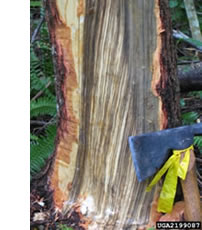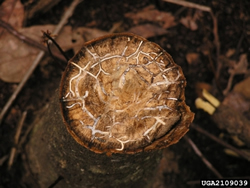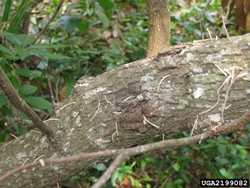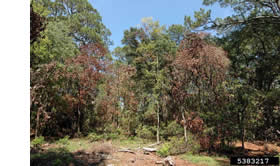
EPPO Alert List – Harringtonia lauricola (laurel wilt) and its insect vector (Xyleborus glabratus)
Why
In the Southeastern part of the USA, widespread mortality of redbay (Persea borbonia) has been observed since 2003. The disease has been called ‘laurel wilt’. The cause of this tree mortality has been identified as Raffaelea lauricola, a fungus which serves as a food source for the redbay ambrosia beetle, Xyleborus glabratus (Coleoptera: Scolytidae). Recent taxonomic studies on the order Ophiostomatales have concluded that this fungus should be moved to a new genus and called Harringtonia lauricola. Both the pathogen and the insect vector originate from Asia and have shown invasive behaviour in the USA. In addition to P. borbonia, H. lauricola has been detected in avocado trees (P. americana) in Florida also causing a vascular wilt disease. As in the USA, both H. lauricola and its insect vector are perceived as a serious threat to the avocado fruit production, the EPPO Secretariat decided to add them to the EPPO Alert List.
Where
X. glabratus is native to Asia (India, Myanmar, Japan and Taiwan) where it infests aromatic tree species (mainly from the Lauraceae family). Studies of an insect collection in Beijing have shown that X. glabratus also occurs in China. H. lauricola has been isolated from X. glabratus beetles collected from Kyushu Island (Japan) and Taiwan. However, differences in the mycangial mycoflora of X. glabratus in Taiwan, Japan and USA, suggest that the X. glabratus population established in the USA probably originates from another part of Asia. In the USA, X. glabratus was first caught in May 2002 in a trap located at Port Wentworth (near Savannah, Georgia). Soon after, widespread mortality of redbay (P. borbonia) was observed in the coastal plains of Georgia and other US states. In 2007, H. lauricola was detected for the first time in an avocado tree in Jacksonville, Florida. As of July 2013, H. lauricola has been detected in 90 avocado trees in various commercial groves of Florida, and more than 1 900 symptomatic trees have been removed as part of a suppression and sanitation strategy. Interestingly, only 6 X. glabratus beetles could be caught in these avocado groves.
H. lauricola
EPPO region: absent.
Asia: Japan, Taiwan.
North America: USA (Alabama, Florida, Georgia, Kentucky, Louisiana, Mississippi, North Carolina, South Carolina, Tennessee, Texas, Virginia).
X. glabratus
EPPO region: absent.
Asia: Bangladesh, China (Fujian, Hunan, Sichuan), India (Assam, West Bengal), Japan (Kyushu), Myanmar, Taiwan.
North America: USA (Alabama, Florida, Georgia, Kentucky, Louisiana, Mississippi, North Carolina, South Carolina, Tennessee, Texas).
On which plants
Laurel wilt has been observed in Lauraceae (in Asia, the fungus has been detected only in the vector for the moment). H. lauricola infects P. borbonia (redbay), P. palustris (swampbay), Sassafras albidum and P. americana (avocado). In USA, P. borbonia and P. palustris are common, shade tolerant, broadleaved evergreen trees of various forested habitats and residential areas of the Southeastern Atlantic coastal plain region. H. lauricola has also been isolated from Lindera melissifolia, Litsea aestivalis and Lacaria trianda which are considered as endangered species but the impact of laurel wilt on these trees remains uncertain. In 2013, a single Laurus nobilis tree was found infected in Florida.
In its native range, X. glabratus is often associated with Lauraceae (e.g. Cinnamomum camphora, C. osmophloeum, Lindera latifolia, Litsea elongata, Machilus nanmu, Phoebe lanceolata, Phoebe neurantha, Phoebe zhennan). However, it is also found on trees belonging to other plant families such as: Leucaena glauca and Lithocarpus edulis (Fagaceae), Schima superba (Theaceae), Shorea robusta (Dipterocarpaceae). In the USA, X. glabratus has been found attacking P. americana (avocado), P. borbonia (redbay), P. palustris (swampbay) and Sassafras albidum.
Damage
Symptoms of laurel wilt are typical of those that are caused by other vascular wilt pathogens: vascular black discoloration, rapid wilting, necrosis of foliage and defoliation. It has been shown that xylem function and hydraulic conductivity were significantly impaired by H. lauricola infection. Glasshouse and field experiments conducted on several avocado cultivars have also shown that a single inoculation resulted in most cases, in extensive colonization and symptom expression. It is not known how many individuals of X. glabratus are needed to result in lethal infection, but observations suggest that one or only a few beetles are required. Laurel wilt has caused widespread mortality of P. borbonia and P. palustris in the USA, killing nearly all trees within 3-5 years after X. glabratus becomes established and detected. In some areas, up to 90% tree mortality has been noticed. In some areas in Georgia, the composition of forest communities was altered by H. lauricola, as after the destruction of P. borbonia, other tree species (e.g. Magnolia virginiana and Gordonia lasianthus) became dominant.

X. glabratus makes pinhole-sized entrance holes in the bark that either bleed or produce light-coloured boring dust. It bores characteristic galleries in the wood of infested trees. X. glabratus can produce frass tubes that resemble ‘tooth picks’ extending out from the bark. However, it is more common to see piles of sawdust around the base of the tree than the tubes themselves. Adults are small beetles, 2-3 mm long, slender, and brown-black in colour. Larvae are white coloured, c-shaped, legless with an amber-coloured head capsule. Little information is available about the life cycle of X. glabratus. Generation time is uncertain but observations indicated that brood development can occur in 50-60 days in Southeastern USA. Ambrosia beetles are usually found on dead or weakened trees, but X. glabratus is able to attack healthy trees. It is considered that young trees with a diameter less than 2.5 cm cannot sustain populations of X. glabratus.


Dissemination
H. lauricola moves primarily via its vector, X. glabratus. Fungal spores are carried in the insect mycangia (specialized structures found at the base of each mandible) and are dispersed in the xylem as the adult female constructs her galleries and lay eggs. Adults and larvae feed on the conidia produced by the fungus. In the USA, it is suspected that X. glabratus (carrying H. lauricola) was introduced with wood packing material from Asia. Once introduced, the movement of infested firewood is considered to be an important means of dissemination within the USA. The survival of X. glabratus and H. lauricola in wood chips made from infested P. borbonia trees has been studied. Chipping can significant reduce the number of X. glabratus and limit the persistence of H. lauricola but does not completely eliminate them.
Pathways
Plants for planting, wood and bark, wood chips, wood packaging material of host trees from countries where H. lauricola and X. glabratus occur. According to preliminary studies, avocado fruit is not a pathway.
Possible risks
Avocado is not widely grown in the EPPO region but is of economic importance at least in Israel and Spain. Laurel forests (including Lauraceae genera such as Apollonias, Ocotea, Persea) are found in the Azores, Madeira (PT) and Islas Canarias (ES). Although their susceptibility to H. lauricola and X. glabratus is not known, they are of high patrimonial value. The recent detection in Florida of the disease on L. nobilis, a species originating from the Mediterranean area and widespread in Europe, is of concern. The insect vector, X. glabratus has cryptic habits and is therefore difficult to detect. In the USA, laurel wilt is perceived as a serious threat to the avocado production. In Florida, expected losses in the absence of control measures were estimated at 27 to 54 million USD. In infected avocado groves, control strategies rely on the following methods: destruction of infected trees, control of X. glabratus (insecticides, attractants (e.g. manuka and phoebe oil lures) or repellents), and severing of root grafts. For the moment, it seems that no tolerant or resistant avocado cultivars are available.
Finally, recent studies have shown that the transfer of H. lauricola from diseased trees to insects other than X. glabratus was possible (e.g. Xyleborus affinis, Xyleborus bispinatus, Xyleborus ferrugineus, Xyleborus volvulus, Xyleborinus gracilis, Xyleborinus saxeseni, Xylosandrus crassiusculus, and a non-ambrosia beetle Apteromechus ferratus), and that transmission to healthy trees was in some cases obtained. Although more studies are needed to confirm these preliminary results, this indicates that ‘new’ vectors might play a role in the disease epidemiology. Considering the significant mortality observed in the USA on several Lauraceae species and the general lack of effective control measures, it is desirable to avoid the introduction of H. lauricola and its vector, X. glabratus in the EPPO region.
Sources
Brar GS, Capinera JL, Kendra PE, McLean S, Peña JE (2013) Life cycle, development, and culture of Xyleborus glabratus (Coleoptera: Curculionidae: Scolytinae). Florida Entomologist 96(3), 1158-1167.
Carrillo D, Crane JH, Peña JE (2013) Potential of contact insecticides to control Xyleborus glabratus (Coleoptera: Curculionidae), a vector of laurel wilt disease in avocados. Journal of Economic Entomology 106(6), 2286-2295.
Cognato A, Smith SM, Li Y, Pham TH, Hulcr J (2019) Genetic variability among Xyleborus glabratus populations native to Southeast Asia (Coleoptera: Curculionidae: Scolytinae: Xyleborini) and the description of two related species. Journal of Economic Entomology 112(3), 274-1284. https://doi.org/10.1093/jee/toz026
Cruz LF, Menocal O, Kendra PE, Carrillo D (2021) Phoretic and internal transport of Raffaelea lauricola by different species of ambrosia beetle associated with avocado trees. Symbiosis 84, 151–161.
De Beer ZW, Parocter M, Wingfield MJ, Marincowitz S, Duong TA (2022) Generic boundaries in the Ophiostomatales reconsidered and revised. Studies in Mycology 101, 57–120. https://doi.org/10.3114/sim.2022.101.02
Dreaden TJ, Davis JM, Harmon CL, Ploetz RC, Palmateer AJ, Soltis PS, Smith JA (2014) Development of multilocus PCR assays for Raffaelea lauricola, causal agent of laurel wilt disease. Plant Disease 98(3), 379-383.
Fraedrich SW, Harrington TC, Bates CA, Johnson J, Reid LS, Best GS, Leininger TD, Hawkins TS (2011) Susceptibility to laurel wilt and disease incidence in two rare plant species, pondberry and pondspice. Plant Disease 95(9), 1056-1062.
Fraedrich SW, Harrington TC, Rabaglia RJ, Ulyshen MD, Mayfield AE III, Hanula JL, Eickwort JM, Miller DR (2008) A fungal symbiont of the redbay ambrosia beetle causes a lethal wilt in redbay and other Lauraceae in the Southeastern United States. Plant Disease 92, 215-224.
Fraedrich SW, Johnson JW, Menard RD, Harrington TC, Olatinwo R, Best GS (2015) First report of Xyleborus glabratus (Coleoptera: Curculionidae: Scolytinae) and laurel wilt in Louisiana, USA: the disease continues westward on sassafras. Florida Entomologist 98(4), 1266-1268. Gazis R, DeWitt KM, Johnson LK, Chamberlin LA, Kennedy AH, Hansen MA, Bush EA (2022) First report of laurel wilt disease caused by Raffaelea lauricola on sassafras in Virginia. Plant Disease 106(6), 1763. https://doi.org/10.1094/PDIS-11-21-2616-PDN
Hughes MA, Black A, Smith JA (2014) First report of laurel wilt caused by Raffaelea lauricola on bay laurel (Laurus nobilis) in the United States. Plant Disease 98(8), p 1159.
Harrington TC, Fraedrich SW, Aghayeva DN (2008) Raffaelea lauricola, a new ambrosia beetle symbiont and pathogen on the Lauraceae. Mycotaxon 104, 399-404.
Harrington TC, Yun HY, Lu SS, Goto H, Aghayeva DN, Fraedrich SW (2011) Isolations from the redbay ambrosia beetle, Xyleborus glabratus, confirm that the laurel wilt pathogen, Raffaelea lauricola, originated in Asia. Mycologia 103, 1028-1036.
Hughes MA, Brar G, Ploetz RC, Smith JA (2013) Field and growth chamber inoculations demonstrate Persea indica as a newly recognized host for the laurel wilt pathogen, Raffaelea lauricola. Plant Health Progress http://sfrc.ufl.edu/forestpathology/wp-content/uploads/2013/12/Hughes-et-al-2013.pdf.
Hughes MA, Shin K, Eickwort J, Smith JA (2012) First report of laurel wilt disease caused by Raffaelea lauricola on silk bay in Florida. Plant Disease 96(6), p 910-911.
Hulcr J, Lou QZ (2013) The redbay ambrosia beetle (Coleoptera: Curculionidae) prefers Lauraceae in its native range: records from the Chinese National Insect Collection. Florida Entomologist 96(4), 1595-1596.
Inch SA, Ploetz RC (2012) Impact of laurel wilt, caused by Raffaelea lauricola, on xylem function in avocado, Persea americana. Forest Pathology 42 https://10.1111/j.1439-0329.2011.00749.x
INTERNET
- Florida Department of Agriculture and Consumer Services, Division of Plant Industry. The redbay Ambrosia beetle, Xyleborus glabratus Eichhoff (Scolytinae: Curculionidae) by AE Mayfield III and MC Thomas (dated 2009) http://freshfromflorida.s3.amazonaws.com/xyleborus-glabratus.pdf
- Forest Health Protection, Southern Region. Laurel wilt. Distribution map. http://www.fs.fed.us/r8/foresthealth/laurelwilt/dist_map.shtml
- University of Florida. IFAS Extension. Redbay ambrosia beetle-laurel wilt pathogen: a potential major problem for the Florida avocado industry by JH Crane, J Peña and JL Osborne (July 2013) http://edis.ifas.ufl.edu/pdffiles/HS/HS37900.pdf
- USDA-Forest Service. EXFOR Datasheet on Xyleborus glabratus. http://spfnic.fs.fed.us/exfor/data/pestreports.cfm?pestidval=148&langdisplay=english
Jeyaprakash A, Davison DA, Schubert T (2014) Molecular detection of the laurel wilt fungus, Raffaelea lauricola. Plant Disease 98(4), 559-564.
Kendra PE, Niogret J, Montgomery WS, Sanchez JS, Deyrup MA, Pruett GE, Ploetz RC, Epsky ND, Heath RR (2012) Temporal analysis of sesquiterpen emissions from manuka and phoebe oil lures and efficacy for attraction of Xyleborus glabratus (Coleoptera: Curculionidae: Scolytinae). Journal of Economic Entomology 105(2), 659-669.
Knutsen MC, Rieske LK (2023) Presence of the causal agent of laurel wilt disease in sassafras-associated insects. Environmental Entomology 52(6), 1042-1047.
Loyd AL, Chase KD, Nielson A, Hoover N, Dreaden TJ, Mayfield AE, Crocker E, Fraedrich SW (2020) First report of laurel wilt caused by Raffaelea lauricola on Sassafras albidum in Tennessee and Kentucky. Plant Disease 104(2), p 567. https://doi.org/10.1094/PDIS-09-19-1914-PDN
Mayfield AE III, Brownie C (2013) The redbay ambrosia beetle (Coleoptera: Curculionidae: Scolytinae) uses stem silhouette diameter as a visual host-finding cue. Environmental Entomology 42(4), 743-750.
Mayfield AE III, Hanula JL (2012) Effect of tree species and end seal on attractiveness and utility of cut bolts to the redbay ambrosia beetle and granulate ambrosia beetle (Coleoptera: Curculionidae: Scolytinae). Journal of Economic Entomology 105(2), 461-470.
Menard RD, Clarke SR, Fraedrich SW, Harrington TC (2016) First report of laurel wilt, caused by Raffaelea lauricola, on redbay (Persea borbonia) in Texas. Plant Disease 100(7), p 1502.
Menocal O, Cruz LF, Kendra PE, Berto M & Carillo D (2023) Flexibility in the ambrosia symbiosis of Xyleborus bispinatus. Frontiers in Microbiology 14, 1110474. Available at https://www.ncbi.nlm.nih.gov/pmc/articles/PMC10018145/
Ploetz RC, Inch SA, Pérez Martínez JM, White Jr TL (2012) Systemic infection of avocado, Persea americana, by Raffaelea lauricola, does not progress into fruit pulp or seed. Journal of Phytopathology 160(9), 491-495.
Ploetz RC, Konkol J (2013) First report of gulf licaria, Licaria trianda, as a suscept of Laurel wilt. Plant Disease 97(9), 1248-1249.
Ploetz RC, Pérez Martínez JM, Smith JA, Hughes M, Dreaden TJ, Inch SA, Fu Y (2012) Responses of avocado to laurel wilt, caused by Raffaelea lauricola. Plant Pathology 61(4), 801-808.
Riggins JJ, Fraedrich SW, Harrington TC (2011) First report of laurel wilt caused by Raffaelea lauricola on sassafras in Mississippi. Plant Disease 95(11), p 1479.
Spence DJ, Smith JA, Ploetz R, Hulcr J, Stelinksi LL (2013) Effect of chipping on emergence of the redbay ambrosia beetle (Coleoptera: Curculionidae: Scolytinae) and recovery of the laurel wilt pathogen from infested wood chips. Journal of Economic Entomology 106(5), 2093-2100.
Seo M, Martini X, Rivera MJ, Stelinski LL (2017) Flight capacities and diurnal flight patterns of the Ambrosia beetles, Xyleborus glabratus and Monarthrum mali (Coleoptera: Curculionidae). Environmental Entomology 46(3), 729-734.
Spiegel KS, Leege LM (2013) Impacts of laurel wilt disease on redbay (Persea borbonia (L.) Spreng.) population structure and forest communities in the coastal plain of Georgia, USA. Biological Invasions 15(11), 2467-2487.
Stocks S (2011) Laurel wilt detected in Miami-Dade country. NPDN First Detector Network News 6(3), 3-4.
EPPO RS 2014/086, 2014/171, 2016/070, 2016/162, 2018/098, 2019/177, 2020/028, 2022/119, 2023/079, 2024/042
Entry date 2014-05


